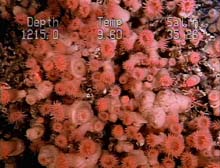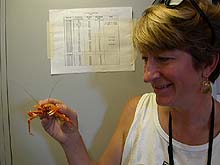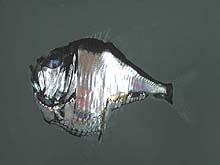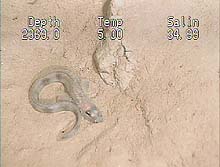
During a dive, the Johnson Sea-Link submersible encountered a "wall" of anemones, soft-bodied organisms that attach themselves to a substrate. When they feed, anemones use their "arms," which encircle their mouths, to "shovel it in." They are related to jellyfish. Click image for larger view.
Sampling the Ocean Realm
September 23, 2001
Liz Baird
Educator-at-Sea
North Carolina Museum of Natural Sciences
Raleigh, NC
When people first began to explore the ocean, they thought that offshore areas were vast deserts with no life. How could life exist in places where the water was too deep for light to penetrate? Sailors, however, told of strange creatures that they encountered at sea. Their stories of strange sea creatures and fanged monsters captured the public imagination. Jules Verne capitalized on this fascination with his novel 20,000 Leagues Under the Sea. In the 18th and 19th centuries, sailors would lower lines with lead weights over the side until they thought the weight had hit bottom. Sometimes the lines were too short, making the ocean appear to be "unfathomable." Soon, measuring the depth was not satisfying enough -- it was time to find out what lived down there. Thus, the exploration of the deep ocean began in the early 1800s.
Ocean sampling continues today as we move forward in our quest to understand ocean life. Identifying life in the world ocean, which comprises 79% of Earth's habitable volume, examining the relationships between these organisms, and observing the populations themselves, help us understand and protect the biodiversity that exists in the deep.

Educator-at-Sea Liz Baird holds a bottom-dwelling lobster (Galathidae). Wire baskets were baited with cat food to lure crustaceans, which the Johnson Sea-Link submersible then brought to the surface. Click image for larger view.
Tiny Wanderers
At the surface, plankton nets catch the smallest organisms floating in the sea. The word "plankton" and "planet" share their origins in a Greek root word that means "wanderers." Plankton are organisms that simply float with the current. Many of them are too small to be seen with the naked eye, although jellyfish are a plankton species. A very fine mesh net is attached to a circular frame that traps organisms larger than 100 microns. A weight on the end of the tapered net keeps it streaming behind the boat, condensing all the plankton into a small container. The plankton net is tossed off the stern and hauled in by hand.
Nekton are organisms in the current that can propel themselves. Some nekton are barely visible, such as the clear, flat, oblong eel larvae, which have two dark eye spots, and the tiniest larval forms of crabs and lobsters. Others are juvenile fish hiding in the giant Sargassum seaweed. Surface nekton is sampled using a Neuston Net, which is attached to a rectangular metal frame that holds it open as it is dragged through the water. Buoys on top of the frame keep it floating at the surface. Last year, the science team often had to measure the Sargassum in 5-gal buckets. This year, however, there has rarely been as much as 1 gal when the net is pulled in. After all of the collected animals are identified, the seaweed is tossed back out to sea, where it drifts along the surface and resumes its "job" as a habitat.

The hatchetfish appears shiny because of its light-producing photophores. Hatchetfish are abundant in the Gulf of Mexico and the Caribbean Sea. Click image for larger view.
IThe Tucker Trawl
Deeper organisms in the water column are sampled with a Tucker Trawl. It is open when it is dropped it into the water off of the stern, and sinks downward because heavy weights are attached at the bottom of the net. When it reaches the target depth, the line is secured and the net is considered to be "fishing." After 30 min, a heavy weight called a "messenger" is sent down to trip the net closed. Then the slow process of hauling the net back in begins. During the earliest explorations of the deep sea in the 1860s, the scientific crew had to use a block-and-tackle to haul in the long meters of rope. Fortunately, today's scientists enjoy the luxury of an electric winch.
The Tucker Trawl brings in a variety of life from the midwater ocean realm. Shrimp are plentiful and come in an amazing variety of sizes and shapes, including some with bright orange bodies and incredibly long antennae, as well as minute versions that would be appropriate as "Barbie Doll" appetizers! Long, slender eels with duckbill-like mouths have been caught on this trip, as have spectacularly shiny hatchetfish. A few nights ago, the trawl brought in a long, ancient-looking fish, with an unusual mouth and jaw that made it look as if its head was disconnecting from its body. Upon closer inspection, this fish, a species of viperfish, was seen to have a mouthful of needle-sharp teeth. A barbel (hanging piece of flesh) under its chin attracts its prey, which it grabs quickly. Creatures like this one lend credence to the old sailors’ tales of sea monsters and dragons inhabiting the deep!

The wolf eelpout is a bottom dweller. Unlike most fish, they do not have a swim bladder. At this latitude, they are only found in deep water,where the temperature range is similar to that of the shallower, northern waters where they are commonly found. Click image for larger view.
The Johnson Sea-Link Submersible
Submersibles allow us to sample the deepest areas of the ocean. The first manned submersible was built in the 1930s. It was a hollow sphere which held two men. Tanks supplied oxygen and a tray of chemicals in the compartment removed the carbon dioxide. The sphere was always tethered to the ship so it rose up and down with every swell. Riding in this contraption does not sound like a pleasant experience. Today’s submersibles are luxurious compared to those humble beginnings. The Johnson Sea Link holds four people in two separate compartments. The scientist and pilot sit in the front and control the video cameras, suction tubes and robotic arms. An observer and a second pilot (who can return the sub to the surface in case of an emergency) sit in the back.
I was an observer on the afternoon dive on the 21st. We descended about 2910 feet off the coast of Cape Hatteras. It was surprisingly clear. With the lights on we could see about 15 feet across the ocean floor. Amphipods (marine pillbug-like creatures) swarmed the external lights, much like moths attracted to a porch light on a summer night. We saw brightly colored shrimp with their long antennae streaming iridescently alongside them, graceful squid, flat witch flounder, narrow eel pouts, orange anemones, and bright red crabs. We videotaped long transects of the floor, recording observations about the depth, the angle of the slope, the temperature of the water and the animals that inhabit each area. The pilot caught a fish using the robotic claw which we brought back to study.
When we began to return to the surface after 4 hours down, we turned off all of the lights (both inside and out) and watched the amazing bioluminescent creatures stream by the window. The sea is as dark as the inside of a cave but it is filled with marvelous greenish lights produced by the deep sea animals. Although I could not see the outlines of any of the creatures, I could tell there were different animals creating the lights. Some lights glowed constantly, others flickered on and off, some streaked by in a row and others seemed to coalesce and disperse randomly. It was mesmerizing. Every dive of the sub brings something different — the scientist aboard can take core samples of the sea floor, collect fish with traps or with suction tubes, or pick up pieces of rock and bring it up in a metal basket mounted to the front of the sub. When the sub hits the surface, everyone comes to help unload and see what the dive has brought in.
Our methods for understanding the ocean have improved dramatically since the first sailor lowered a weighted line overboard, yet only a fraction of the ocean has been studied. Instead of simply focusing on one particular section of the sea, we are just beginning to understand the complex relationships between the animals that live along the surface, in the mid water range and on the bottom of the deep sea.
Sign up for the Ocean Explorer E-mail Update List.











































